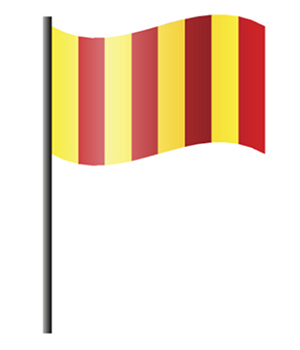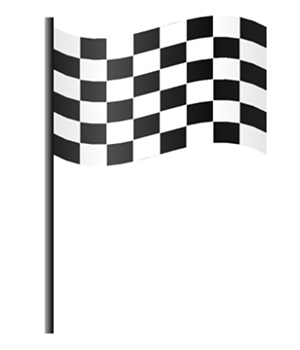Originally published August 29, 2019. Last updated April 15, 2024.
If you are new to HPDE, learning the flags is a great place to start. HPDE organizers use a variety of flags to communicate important information to drivers on the track. Each flag has a specific meaning, and some flags have multiple meanings depending on the context.
Make sure to memorize the following HPDE flags and their meanings before your next event, since each one can require you to take very specific actions to keep the track session safe and fun.

Green Flag
The green flag is used at the start/finish line and generally indicates that the session is in progress, the track is clear and passing is allowed. Some events use this flag to restart a session after another flag has been displayed. Green flag conditions are often assumed in the absence of a green or other flag at a manned corner station.

Yellow Flag
A yellow flag is used in two different ways:
- If a corner worker is holding the flag still with both arms outstretched (referred to as “standing yellow”), it means passing is not allowed because it’s the warmup lap or there is a problem ahead.
- If the flagger is waving a yellow flag, slow down and pay attention because there is likely to be a hazard on the track.

Blue Flag With a Diagonal Stripe
This flag tells you there are faster cars behind you and to let them pass. This flag can be displayed when a car is following very closely as well as when a car is not close but approaching quickly. Consider giving a point-by hand signal to the other car to pass you according to the specific rules of your event.

Yellow Flag With Red Vertical Stripes
This flag is often referred to as the “debris flag” and indicates that there is something potentially hazardous on the track. These track hazards can be numerous, from lost car parts to overturned cones, wayward animals or fluid leaks on the track. If you see this flag, be cautious.

Black Flag
A black flag notifies you that something is wrong with your car or the way you are driving. Ignoring a black flag can ensure your removal from the event. Acknowledge that you see the flag, pit-in and report to the event organizer or track staff to discuss why you received this flag.

Black Flag With an Orange Circle
Affectionately known as the “meatball flag,” the mechanical flag indicates a mechanical problem with your car. Reasons for receiving this flag can vary, from a noticeably loose or missing car part to a serious fluid leak. If you get “meatballed,” slow down and pit in. If a fluid leak is suspected, move off the racing line to avoid creating a slippery hazard for others.
Red Flag
A red flag signifies an emergency and stops a session. Check your mirrors and safely come to a controlled stop as quickly as possible toward the inside of the track and in view of a corner worker. If possible, avoid stops around a blind curve or over a hill. This ensures there is a clear track for emergency responders. Wait for further instructions from a corner worker.

White Flag With or Without a Red Cross
A white flag is another flag that can have several different meanings. Most often a white flag warns drivers that a slow moving vehicle is on the track. These vehicles can include emergency vehicles. However, a few series use the white flag in other ways. Displayed at the start/finish line, it can announce the last lap of a session. Displayed at all active stations during a first lap, a white flag can show which corner stations are manned.

Checkered Flag
The black and white checkered flag marks the end of session. Begin your final cooldown lap and head for the pits. Passing is not allowed on the final lap at most events. Even so, track day organizers usually prefer drivers to keep up a reasonable pace during the cool down lap, since there are often other drivers waiting their turn for a session on the track.
Protecting Your Vehicle on the Track
If you know your HPDE flag meanings by heart, you’re already ahead of the game. Another tip for being prepared come track day: making sure your car is protected on the track.
For a variety of reasons, most regular auto insurance policies don’t cover your car when it is on the track. Here’s how to check your policy to see if it carries this common HPDE exclusion.
If your policy does have an HPDE exclusion, not to worry. Lockton Motorsports offers HPDE Insurance that is specifically designed to protect your car from damage when you’re participating in HPDE, Track Day or Time Trial events.
With your car protected, you can get back to focusing on more important things, like reviewing your flags so that you’ll have a great day at the track.


